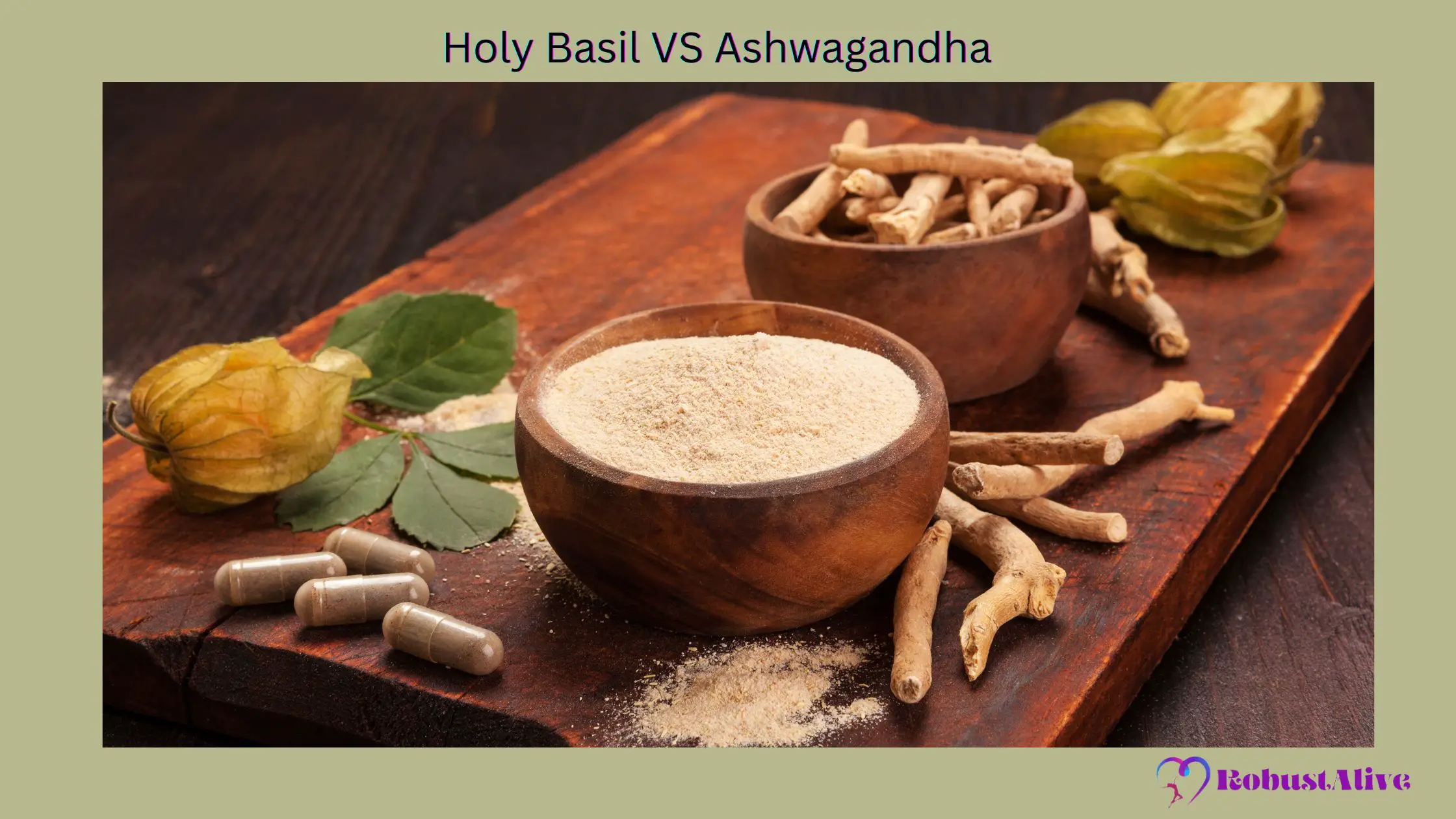Holy Basil Vs Ashwagandha: 9 Unexpected Differences

Within the world of Ayurveda, Holy Basil (Ocimum tenuiflorum) and Ashwagandha (Withania somnifera) have gained recognition for their wide-ranging therapeutic properties.
So, what are the differences in terms of Holy Basil vs Ashwagandha?
Holy Basil (Tulsi) and Ashwagandha are adaptogenic herbs with distinct characteristics. Holy Basil is used in cooking and offers stress management and respiratory health benefits. Ashwagandha is primarily used medicinally and supports stress reduction and cognitive enhancement. They have different tastes, smells, and nutritional profiles. Both herbs have potential side effects and interactions with certain medications, requiring caution.
This article explores Holy Basil and Ashwagandha’s fascinating properties and potential health benefits.
Holy Basil Vs Ashwagandha
Holy Basil and Ashwagandha are powerful adaptogenic herbs with significant health benefits but differ in various aspects. Here is an overview of Holy Basil vs. Ashwagandha:
| Aspect | Holy Basil (Tulsi) | Ashwagandha |
| Origin | Indian subcontinent | India, Middle East, Africa |
| Primary Utilization | Cooking, adaptogen | Medicinal purposes, adaptogen |
| Edible Parts | Leaves, flowers | Roots, leaves, fruits |
| Taste and Smell | Clove-like, spicy, bittersweet | Bitter with mild vegetal and musky notes, unique smell |
| Shelf Life | Best consumed within 1 year | Can last for 2-3 years |
| Physical Characteristics | Leafy green plant with aromatic leaves | Small shrub with yellow flowers and red berries |
| Chemical Composition | Rich in essential oils, eugenol | Contains withanolides |
| Health Benefits | Stress management, anti-inflammatory, respiratory health, immune support | Stress reduction, cognitive enhancement, adrenal health, immune support |
| Side Effects | Mild digestive discomfort, interactions with certain medications | Drowsiness, interactions with certain medications |
Origin and Cultivation
Holy Basil is native to the Indian subcontinent and is cultivated in countries like India, Nepal, and other Southeast Asian regions. It is sacred in Hinduism and is commonly grown in households and temples.
On the other hand, Ashwagandha originates from India, the Middle East, and parts of Africa. It is cultivated in various regions worldwide, including India, the United States, and Europe.
Primary Utilization
Holy Basil is commonly used as an adaptogen and can be found in various Thai recipes, adding its distinct flavor and aroma.
Ashwagandha is also widely utilized as an adaptogen, but it is primarily known for its medicinal purposes. It is occasionally used in cooking, but its roots are mainly utilized for health benefits.
Edible Parts
For Holy Basil, the flowers and leaves are edible and often used in cooking and herbal preparations.
In contrast, Ashwagandha’s roots, leaves, and fruits are used for various health purposes.
Taste and Smell
Holy Basil has a pleasant fragrance and a taste described as clove-like, spicy, and bittersweet.
Ashwagandha’s roots are known to have a unique smell often described as “like a horse,” its taste is bitter with mild vegetal and musky notes.
Shelf Life
Holy Basil is best consumed within one year for the best flavor, while Ashwagandha can last for 2-3 years.
Physical Characteristics
Holy Basil is a leafy green plant with aromatic leaves emitting a pleasant scent. The leaves are commonly used in cooking and herbal preparations.
On the other hand, Ashwagandha is a small shrub with yellow flowers and red berries. The roots of the Ashwagandha plant are typically used for medicinal purposes.
Chemical Composition
Holy Basil and Ashwagandha contain bioactive compounds that contribute to their potential health benefits.
Holy Basil is rich in essential oils, including eugenol, which has antioxidant and anti-inflammatory properties.
Ashwagandha contains several bioactive compounds, including withanolides, which have been studied for their potential anti-stress and anti-inflammatory effects.
Health Benefits
Both herbs offer some similar health benefits, but they also have unique properties.
Holy Basil Benefits:
- It supports stress management and promotes relaxation.
- It may help reduce inflammation in the body.
- It supports respiratory health and boosts the immune system.
Ashwagandha Benefits:
- Reduces stress and anxiety.
- It improves cognitive function and enhances memory.
- It supports adrenal health and promotes a healthy immune system.
Nutritional Value of Holy Basil and Ashwagandha
They both have different nutrition profiles.
Nutrition Facts of Holy Basil (Tulsi) per 100 grams:
| Nutrient | Amount |
| Calories | 27 kcal |
| Total Carbohydrate | 4.34 g |
| Dietary Fiber | 3.9 g |
| Protein | 2.54 g |
| Calcium | 154 mg |
| Iron | 3.17 mg |
| Vitamin C | 18 mg |
Nutrition Facts of Ashwagandha per 100 grams:
| Nutrient | Amount |
| Calories | 245 kcal |
| Total Carbohydrate | 49.9 g |
| Dietary Fiber | 32.3 g |
| Protein | 3.9 g |
| Calcium | 23 mg |
| Iron | 3.3 mg |
| Vitamin C | 3.7 mg |
We can see that Holy Basil (Tulsi) has significantly lower calories, carbohydrates, and dietary fiber compared to Ashwagandha. However, Holy Basil contains higher amounts of calcium and vitamin C than Ashwagandha. The protein and iron content is relatively similar between the two herbs.
It’s important to note that these values are based on the general nutritional composition of Holy Basil and Ashwagandha. Still, they vary depending on the variety, growing conditions, and processing methods.
Side Effects and Precautions
While both herbs are generally safe for most people, there are some side effects and precautions to consider.
Holy Basil Side Effects:
- It may cause mild digestive discomfort in some individuals.
- It may interact with certain medications, including blood thinners.
- Pregnant and breastfeeding women should consult a healthcare professional before using Holy Basil.
Ashwagandha Side Effects:
- It may cause drowsiness in some individuals.
- It may interact with certain medications, including sedatives and immunosuppressants.
- Pregnant and breastfeeding women should consult a healthcare professional before using Ashwagandha.
Holy Basil: The Queen of Herbs
Holy basil, known as tulsi or Ocimum tenuiflorum, is an aromatic subshrub hailing from the Lamiaceae plant family. With its revered status in Hindu culture, holy basil has earned titles like “the queen of herbs” and “mother medicine of nature.” This esteemed herb plays a vital role in Ayurveda, which has been used for centuries to promote overall well-being.
Holy Basil Uses
Holy basil’s potent flavor, spiciness and bittersweet notes reminiscent of clove, make it an excellent culinary herb in various Thai dishes. Additionally, brewing tea from its flowers, leaves, or dried leaf powder is a popular way to enjoy its numerous benefits. Notably, holy basil is utilized in skincare products due to its antimicrobial and antioxidant properties, which help alleviate inflammation, joint pain, and acne.
Health Benefits of Holy Basil
Holy basil is an outstanding remedy for stress, anxiety, and stress-related problems. Its adaptogenic properties assist in reducing symptoms of insomnia, forgetfulness, exhaustion, and male impotence. Furthermore, holy basil exhibits anti-diabetic properties by helping to lower blood sugar and cholesterol levels. It also aids in countering ulcers caused by stress, safeguarding the stomach.
Studies indicate that holy basil has the potential to inhibit the growth of cancerous cells and acts as a natural anti-inflammatory agent. Furthermore, it bolsters the immune system, protecting against illnesses and promoting overall vitality.
Recommended Dosage of Holy Basil
Holy Basil dosage can vary depending on the specific condition you are targeting. For anxiety and depression, a recommended short-term dose is 500 mg of Holy Basil leaf extract taken twice daily. A 30-day regimen of 300 mg daily is suggested for central nervous system disorders.
To alleviate stress symptoms like fatigue and sleep problems, a dose of 400 mg in the morning and 800 mg at night can be effective.
How to Store Holy Basil
Store the leaves or flowers in an airtight container for dried holy basil in a cool, dark, and dry place. This ensures the herb retains its flavor and potency for up to a year. Fresh tulsi requires drying before storage. Cut the stems, shake off any bugs, and hang the bunches upside down in a cool, dark spot for around two weeks. Once dry, store the leaves as instructed above.
Ashwagandha: The Indian Ginseng
Ashwagandha, scientifically known as Withania somnifera, is an evergreen shrub native to drier regions of India and South Asia. Despite its name, Ashwagandha is entirely safe and consumed by many. Its name translates to “smell of a horse,” alluding to the plant’s roots, which emit a scent reminiscent of a horse.
Ashwagandha Uses
Ashwagandha’s bitter taste and mild vegetal and musky notes make it less common in cooking, unlike holy basil. Instead, it is predominantly used in Ayurveda as a potent medicinal herb. The roots are often ground into a powder or chopped for various uses, while the leaves are employed in tea-making.
Health Benefits of Ashwagandha
Ashwagandha is adaptogenic and provides a wide array of health benefits. One of the key advantages of Ashwagandha is its ability to combat stress and anxiety. Reducing cortisol levels, the stress hormone helps promote a sense of calm and relaxation. This, in turn, can lead to improved sleep quality, making it beneficial for those suffering from insomnia or restless nights.
Moreover, Ashwagandha is known for its positive effects on cognitive function. Studies have shown that regular consumption of Ashwagandha can enhance memory, focus, and overall brain function. It may also aid in reducing symptoms of depression, making it a valuable natural remedy for those experiencing mood imbalances.
The herb’s anti-inflammatory properties benefit individuals with arthritis, joint pain, and muscle stiffness. Ashwagandha’s ability to lower inflammation contributes to its potential to reduce the risk of chronic diseases.
Additionally, Ashwagandha is often used to support male reproductive health. It has been associated with increased testosterone levels and improved sperm quality, making it a potential aid for men dealing with fertility issues.
Recommended Dosage of Ashwagandha
Ashwagandha dosage is not set in stone due to its adaptogenic nature. The dosage depends on your desired outcome. A range of 125 mg to 5 g is recommended for stress reduction.
To combat inflammation and infections, a dose of 250 mg or 12 ml can be effective. A daily dose of 500 mg to 600 mg of Ashwagandha root extract is suggested for cognitive enhancement.
How to Store Ashwagandha
Like holy basil, Ashwagandha root can be stored in an airtight container in a cool, dark place to preserve its potency. The dried roots can last up to a year when stored correctly. For ashwagandha leaves, they can be dried and stored in the same manner as holy basil leaves.
Holy Basil VS Ashwagandha: Which One Should You Choose?
Choosing between Holy Basil and Ashwagandha can be subjective based on your health needs and goals. Both herbs offer potential health benefits and have been used in traditional medicine for centuries. Here are some factors to consider when deciding which herb to choose.
- If you’re looking for a natural way to manage stress, promote relaxation, and support your immune system, Holy Basil could be a suitable option for you.
- Ashwagandha might be a better choice if you’re seeking a natural remedy to reduce stress, boost cognitive function, and support overall well-being.
- When deciding, consider factors such as dosage, formulation, shelf life, organic certification, side effects, customer reviews, and price. Consider the preferred form of consumption, whether it’s capsules, pills, gummies, or powders.
- Look for products with organic certification to ensure they are free from harmful chemicals. Read customer reviews from reputable sources to gather insights and experiences from others. Finally, consider the price and quantity of the herbal supplements and the availability of a money-back guarantee.
Can Holy Basil And Ashwagandha Be Taken Together?
Yes, you can take Holy Basil and Ashwagandha together. They are often combined and have been used in traditional Ayurvedic medicine for a long time. Both herbs have similar benefits and are considered adaptogens, meaning they can help the body adapt to stress and promote overall well-being.
Taking Holy Basil and Ashwagandha together can provide a range of health benefits. They can help reduce stress, improve mental clarity, support healthy cortisol levels, and have anti-inflammatory effects. They can also support brain function, heart, lung, and joint health.
Combining The Power Duo
The synergistic effects of holy basil and Ashwagandha make them ideal for managing stress and promoting overall well-being. Together, they work harmoniously to balance the body’s stress response, providing a more comprehensive approach to combat stress-related issues.
One common way to consume these adaptogens is by brewing a tea combining holy basil and Ashwagandha. The tea offers a delightful flavor and maximizes the benefits of both herbs. To make the tea, steep a teaspoon each of dried holy basil leaves and ashwagandha roots in hot water for 5-7 minutes. You can add honey or lemon to enhance the taste.
Final Words
In conclusion, when it comes to Holy Basil VS Ashwagandha, both offer numerous health benefits and have distinct characteristics that set them apart. Most importantly, Holy Basil is commonly used in cooking and offers stress-relieving properties.
On the other hand, Ashwagandha is primarily used for its adaptogenic and medicinal purposes, supporting stress reduction, cognitive function, and adrenal health. Knowing the potential side effects and precautions associated with each herb is important.





